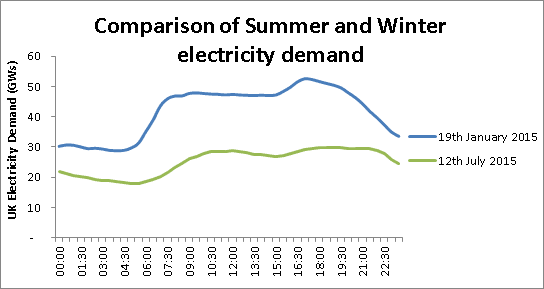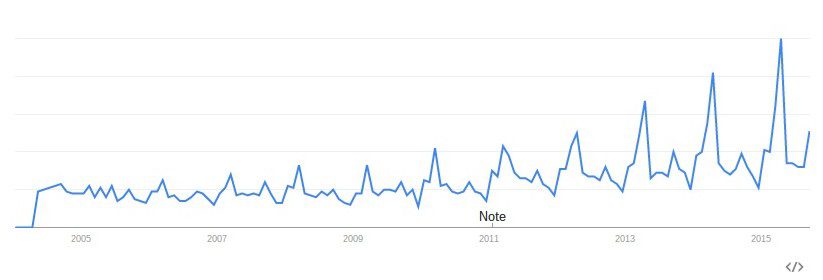The Peak Demand Problem
What do public services have in common with the world of energy production and smart meters? The answer may be of interest to government departments seeking to identify budget savings of 25-40% in response calls for £20 billion of Whitehall cuts by 2020.
Let me explain.
One of the major challenges for power generation is not about meeting average demand, but instead having enough power stations to meet peak demand, which typically occurs on Winter evenings. The network also needs to be able to handle sudden surges in energy consumption, such as when everyone switches on their kettle at the commercial breaks during the X Factor or the World Cup, so capacity is kept in reserve. Since demand comes in peaks and troughs, during much of the day (and particularly in Summer) many power stations stand idle.

Winter peak demand is 52.5GW (typically occurring winter evenings) | Summer minimum demand is 18GW (typically occurring summer mornings)
This leads to an interesting thought.
If the peaks of electricity consumption could be evened out, it would be possible to decommission some existing (or avoid having to build some future) power stations while still ensuring security of supply. A natural gas powered station such as Immingham can cost around £350 million; the nuclear power plant at Hinkley Point C cost £16 billion – and those are just the capital costs. Reducing peak demand means we can build fewer power stations, which could save the UK literally billions of pounds.
Policymakers are excited by the potential for smart meters to do just that by enabling ‘demand side response’. (The UK plans to roll out around 50 million smart meters across the country by 2020). Put simply: smart meters could give consumers real-time pricing information, encouraging them to switch off appliances during peak periods and instead use them when the price of energy is low.
In short, billions of pounds could be saved by changing consumers’ behaviour.
Public sector parallels?
Could it be that – like the world of power generation – government and public sector organisations also suffer from this ‘peak demand problem’? Put differently, is a significant proportion of the cost of providing some public services associated with meeting peak demand that is well above average use?
In some domains, the answer appears to be yes. Consider that:
– 80% of all online self-assessment tax returns are submitted in the last few days of January. HMRC has to have sufficient server power, call centre and back office staff to handle this demand. Similarly:
– The majority of all applications for tax credit renewals happen in July, creating the same issues for DWP.
– A&E departments often see a surge of demand on Friday and Saturday evenings. This requires having enough staff, beds and equipment to meet those peak levels.
A simple analysis of some Google search trends helps to reveal (or to confirm expected) public service demand peaks. The following graph shows the distribution of UK searches for ‘school places’.

If the peak demand problem is the same, might the solution be, too? Could technology be used to influence citizens’ behaviour to reduce peak demand in public services?
Again, I believe the answer is yes.
People who liked nudge also liked “digital nudge”
The concept of trying to influence people’s behaviour is well known in policymaking circles. The idea was neatly encapsulated by Richard Thaler and Cass Sunstein in their 2009 book, Nudge, which explained that, given the right prompts or incentives (whether consciously realised or not), people can be ‘nudged’ into changing their habits in a desired direction. Examples might include eating more healthily, paying tax on time or saving for a pension. Embracing the idea, in 2010 the coalition government even created its own ‘Nudge Unit’ – officially the Behavioural Insights Team (BIT) – whose activities have been inspiringly documented in David Halpern’s recent book Inside the Nudge Unit.
Significantly, many nudge prompts are based on providing information – or communicating a message – to a person in a certain way. And this is something that technology is incredibly well suited to deliver. Many technology companies are already highly experienced at shaping their users’ behaviour through digital channels. Amazon’s famous “Customers who bought X also bought Y” is just one of hundreds of examples that could be given.
Perhaps what we should be aiming for is, therefore, “digital nudge”.
All this could lead to a significant consequence.
Instead of (or perhaps, in addition to) government departments and public sector organisations scaling back or stopping some services, cost reductions could be found by tackling the peaks in demand. By using digital nudge to spread out citizens’ consumption of public services, the same number of people could be served using fewer resources.
The challenge is, of course, connecting specific instances of the peak demand problem with specific digital nudge techniques that help combat them. To understand how that might work, consider three distinct ways in which peaks form.
The three peaks challenge
1 – Peaks in the delivery of a standard service
The simplest form of peak is that found when there is a predictable cycle of rising and falling demand for a certain service. To identify these, simply look for any process where government imposes a deadline: submitting a self assessment tax return; applying for a tax credit renewal; applying for a school place, registering for the electoral roll and so on.
In some cases technology is making such deadlines less significant by enabling the flow of real-time information – as is already happening with tax. Where that is not possible, perhaps digital nudge could help instead. The Behavioural Insights Team has summarised the Nudge approach into four characteristics. If you want to encourage a certain behaviour – including avoiding times of peak demand – you need to make it Easy, Attractive, Social and Timely (EAST).
Technology can enhance all those things.
It can make it easy to avoid peaks by removing the friction of doing something at quieter times – perhaps providing a website showing live information on the busiest and quietest times for call centres and offering a one-click call back request.
It can make early submissions attractive by personalising the message – think of how Google adapts its services based on a person’s age, location and past behaviour.
It can extend social norms through social media.
Critically, for avoiding peaks, it can make things timely by prompting people via push notifications to their smartphones.
The Nudge unit has already used its armoury of techniques to encourage people to pay fines in good time through the better wording of letters. Why not use technology like smartphones to enable digital nudge prompts to encourage early activity or behaviour on any number of areas where peaks appear?
2 – Peaks caused by people falling out of mainstream services
One of the most expensive aspects of public service provision comes in addressing the needs of people who have fallen out of mainstream services. They represent a peak of workload or expense, rather than one appearing at a specific time. To be clear, it is absolutely right and necessary that public services do exist to support those who fall out the system. Yet, in at least some cases, it would be far better for both the individual and the service provider to minimise the number of those that do so.
Take, for example, young people who are not in education, employment or training (NEETS). In 2011 it was estimated that each 16-18 year-old NEET costs the state an average of £56,000 up to the age of retirement (through benefit payments, lost tax revenue and healthcare and criminal justice costs). The aggregated lifetime cost of the NEETs aged 16-18 at the end of 2008 has been estimated at being between £12 and £32 billion. (And that does not begin to factor in the untold personal misery caused to the individuals affected.)
How could digital nudge help?
Technology companies are masters at finding ways to maintain a person’s engagement in a process. For example, Zynga (creator of Farmville) dynamically changes the game to keep users engaged when it looks like they may be losing interest. An algorithm monitors each user’s playing habits and – if needed – provides them with an incentive to stay, such as giving them a free token for the next level. Similar gamification techniques are used by app designers to keep people exercising, dieting, learning languages, and staying off drink or cigarettes. It does not seem far-fetched to suppose that similar methods could be used to encourage some would-be NEETS to stay in education or training.
3) General demand contributing to peaks
Finally, there are some types of peak where it may seem impossible to address the underlying cause. A&E departments, for example, can be particularly busy on Friday and Saturday evenings. A major contributing factor is thought to be the higher rate of alcohol related incidents, as people go out for end-of-week drinks. There is little that nudging can do about that.
However.
It is also known that around 1 million people each year go to A&E because they could not get a GP appointment. Now that is a problem that digital nudge could address.
One of the reasons that people cannot see their GP is that some patients fail to turn up to their appointments, needlessly blocking doctors’ time. In fact, figures suggest that more than twelve million GP appointments are missed each year in the UK, costing in excess of £162 million per annum. Solving just a twelfth of that number could dramatically reduce pressure on A&E departments.
How could that be done? Some surgeries already send a text message to people on the morning of their appointment as a reminder to attend. The digital nudge aspect would be the content of that text message. David Halpern gives the example of how the wording of SMS messages sent to job seekers had a substantial effect on how many turned up to jobs fairs. Sent a standard, impersonal text message, around one in ten turned up. However:
“adding the recipient’s name at the beginning of the text increased the proportion turning up by 5 percentage points, or 15 per cent… What if the adviser also added their own name? The number turning up rose even further, to 18 per cent. And how about if the adviser instead wrote: ‘I’ve booked you a place… Good luck!’ Now the proportion turning up rose to an impressive 27 per cent, a nearly threefold increase.”(David Halpern, Inside the Nudge Unit, p.121)
In a similar way, if it were possible to a) roll out text messaging to all GP surgeries, and b) increase the effectiveness of the wording, achieving anything like the same 27% improvement could free up hundreds of thousands of GP hours. It may not solve the alcohol related incidents, but it would help reduce the peaks on Friday and Saturday nights all the same by removing patients waiting because they could not see their GP.

